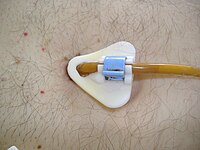
Photo from wikipedia
Endoscopic ultrasonography-guidedpancreatic drainage (EUS-PD) is challenging owing to technical difficulties. The most important factor for these difficulties is the risk of guidewire dislodgement due to the short length of the… Click to show full abstract
Endoscopic ultrasonography-guidedpancreatic drainage (EUS-PD) is challenging owing to technical difficulties. The most important factor for these difficulties is the risk of guidewire dislodgement due to the short length of the guidewire, which can be left in the pancreatic duct (PD). The double-guidewire technique for EUS-guided hepaticogastrostomy has been shown to be effective to stabilize an endoscope and prevent guidewire dislodgement [1, 2]. Herein, we report that this technique is useful for EUS-PD. A 71-year-old man underwent pancreaticoduodenectomy for intraductal papillary neoplasm 1 year prior to presentation at our hospital. Six months after the initial surgery, the tube that was placed through the pancreaticogastric anastomosis was dislodged. Diabetes mellitus was diagnosed with an increase of HbA1c from 5.7% to 7.0% in the following 3 months. Computed tomography imaging revealed dilatation of the PD and obstruction of the pancreatogastric anastomosis (▶Fig. 1). EUS-PD was performed to prevent the exacerbation of pancreatic function (▶Fig. 2). The PD was punctured at the pancreaticogastric anastomosis using a 19-gauge needle, and a 0.025-inch hydrophilic guidewire was manipulated in the duct. A drill and balloon dilator were advanced to the fistula; however, a plastic stent could not be inserted beE-Videos
Journal Title: Endoscopy
Year Published: 2022
Link to full text (if available)
Share on Social Media: Sign Up to like & get
recommendations!